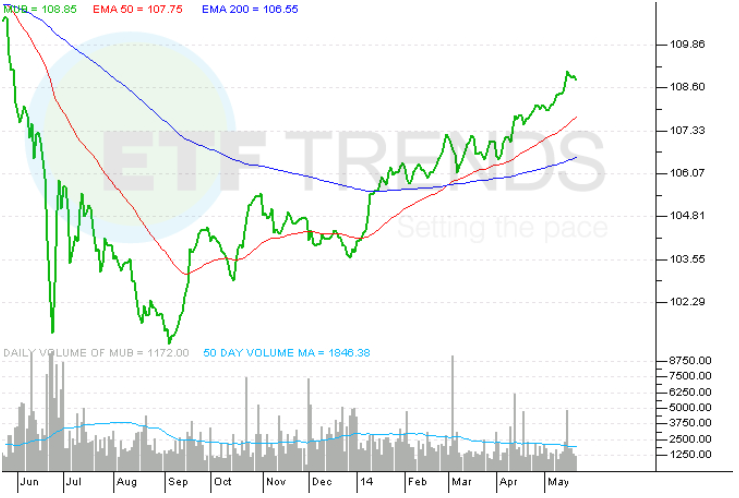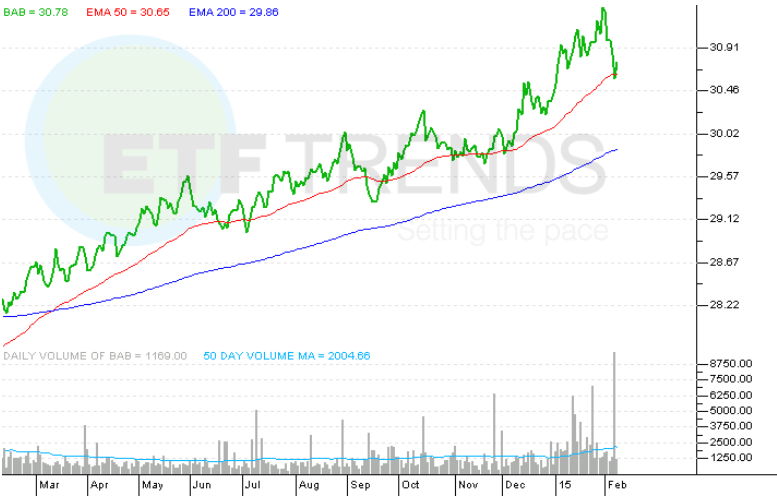ETFs Munis
Post on: 9 Май, 2015 No Comment

As municipal-bond exchange-traded funds proliferate, here’s what you need to know about them
Think of the world of exchange-traded funds as a vast ice-cream store: With hundreds of flavors on the board already, plain vanilla just got added.
In a reversal of the usual order of things, one of the blandest and most conservative of investments now has an ETF to call its own: the municipal bond. And muni-bond ETFs are coming fast and furious.
The Journal Report
In September, Barclays Global Investors, a unit of Barclays PLC, introduced the first muni-bond ETF, iShares S&P National Municipal Bond Fund. On the same day, State Street Corp.’s State Street Global Advisors announced its plan to roll out the second one, SPDR Lehman Municipal Bond ETF, which started trading on the American Stock Exchange three days later.
Barclays has started two more since — one focused on California bonds and the other on New York issues. And State Street launched another three last month: California and New York specialty ETFs, as well as SPDR Lehman Short Term Municipal Bond.
PowerShares Capital Management LLC, a unit of Invesco PLC, listed three on the Amex last month: PowerShares Insured California Municipal Bond Portfolio. PowerShares Insured New York Municipal Bond Portfolio and PowerShares Insured National Municipal Bond Portfolio. Meantime, Van Eck Global, a New York-based investment firm, filed an application for six such products in late July, including one that will hold high-yield, or junk, municipal bonds.
In the ETF world, the first mover usually has an advantage in gathering assets. Once Barclays’ ETF opened for business, rivals couldn’t wait for it to establish itself too firmly, says Matt Fabian, a senior analyst with Municipal Market Advisors, an independent research firm in Concord, Mass.
As plain vanilla as muni bonds may be, muni-bond ETFs are anything but straightforward. They are one of the more complicated ETFs to arrive so far. And that’s one reason they have been late arriving on the scene.
Here, then, is everything you need to know about muni-bond ETFs, in the simplest terms.
Q) What is a muni-bond ETF, and how is it different from a muni-bond mutual fund?
A) Municipal bonds are debt issued by state or local governments to finance public projects. For now, let’s leave out the nuances in fund structures and focus on what matters most to individual investors: Both muni-bond mutual funds and ETFs allow investors to pool their money and hire professionals to choose their bonds.
Investors are entitled to a monthly distribution of the interest income carried by the bonds in the fund. This income is exempt from federal income tax, and in many cases it’s exempt from state and local taxes as well. Capital-gains distributions aren’t tax-exempt, but such distributions tend to be relatively small at most muni-bond funds to start with. ETFs in general have fewer capital-gains distributions than mutual funds. (More on ETFs’ structure later.)
All bond funds pose some risk. Yields move in the opposite direction of bond prices. So, if yields rise, a bond drops in value. That isn’t a problem if you hold an issue until it matures; provided the issuer hasn’t had severe financial problems, you’ll get your principal back. But the net-asset value of a bond fund is based on daily values, so shareholders selling as interest rates are surging will be hit by falling bond prices.
Now for the differences: The ETFs announced so far track muni-bond indexes — that is, they seek to replicate the price and yield performance of a designated benchmark. Some mutual funds also track indexes, but most are run by managers who pick and choose securities individually.
Investors can buy and sell ETF shares throughout the day on a stock exchange, paying the going price. Mutual funds are priced once daily.
Q) Why were bond ETFs slower in general than stock ETFs to appear? And why did it take five years from the start of the first bond ETF for a muni-bond ETF to be created?
A) By and large, ETFs track market indexes, and this has proved nettlesome on the bond side. That’s because bonds are traded through securities firms — not on exchanges, like common stocks. So it can be tough to physically locate some of the bonds that constitute an index.
The trading issue happens to be particularly acute with municipal bonds because many of their buyers are buy-and-hold types. Municipal bonds are not ideally suited for the ETF structure, says Mark McCray, a managing director for Pacific Investment Management Company LLC’s municipal-bond portfolios.
Q) Which indexes do muni-bond ETFs follow?
A) State Street’s first muni-bond ETF is benchmarked against the Lehman Brothers Municipal Managed Money Index. The index, started in 2004, is made up of more than 22,000 muni bonds with ratings of Aa3/AA- or higher. State Street’s other ETFs also will track Lehman muni-bond indexes, as will Van Eck’s.
Barclays is using a new index from Standard & Poor’s, the S&P National Municipal Bond Index of 3,069 issues with a rating of triple-B-minus or better from at least one of the three major rating agencies. Meantime, PowerShares is using an index customized for it by Merrill Lynch & Co.
Q) Will muni-bond ETFs hold all of the securities in these indexes — thousands and thousands of bonds?
A) It’s virtually impossible, says Jim Ross, senior managing director of State Street Global Advisors.
Instead, these ETFs are using a representative sampling to track their indexes. State Street’s ETF has about 37 out of the more than 22,000 constituents in its index. The Barclays ETF holds about 36 of the 3,069 index constituents. The firms say small numbers aren’t a problem given their expertise in sampling.
At State Street, portfolio managers look at muni bonds’ durations, yields, credit quality and place of issuance to decide on the ones with characteristics representative of the index. Managers seek the most heavily traded among them. The only way to test liquidity is to call traders and get multiple bids, says Mr. Ross. We have spent a significant amount of time back-testing the sample.
Barclays tweaked its ETF model and devised a liquidity scoring system to identify the most frequently traded issues, according to Matt Tucker, Barclays’ head of fixed-income investment solutions.
Some analysts say that the firms’ approach may give the ETFs a different flavor than the muni-bond indexes they track because an index’s return partly is affected by the thin trading of some components. The illiquid bonds are part of the index, and they behave in many environments differently than the other bonds, says Milton Ezrati, senior economic and market strategist with Lord, Abbett & Co. LLC, a Jersey City, N.J. money manager. If they only buy the liquid bonds, their samples will stray in terms of performance from the index that people think they are buying.
Q) Does this mean that the ETFs could have a big tracking error?

A) When a fund’s return doesn’t match that of the index, tracking error emerges. Mr. Ross at State Street says tracking errors can happen, in a positive way or a negative way. State Street expects to track the index within a range of 0.50 to 0.75 percentage point. In contrast, U.S. stock ETFs tracking broad market indexes have very little tracking error.
Barclays’ prospectus for its muni-bond ETF cautions that the use of representative sampling can result in greater tracking error. It says that imperfect correlation between the fund’s securities and those in the underlying index, rounding of prices and fees and expenses may cause the error.
Mr. Fabian of Municipal Market Advisors calls the sampling techniques an evolution. Still, the firms say they are confident. You can actually track a very large index with a few issues, says Barclays’ Mr. Tucker, because most fixed-income securities have the common factors of risk.
Q) So what does all this mean in terms of the yield that an investor will receive?
A) Thanks to their low expenses, muni-bond ETFs offer attractive yields. The first two ETFs from Barclays and State Street are yielding 3.75% and 4.42%, after expenses. That compares with a yield of 3.84% on the average long-term national muni bond fund, according to Morningstar Inc. Vanguard Long-Term Tax-Exempt Fund Investor Shares, with expenses of 0.16%, is yielding 4.09%.
As with other debt investments, in general, the longer the duration — or the remaining term to maturity the underlying bonds — the higher the yield return. Investors get compensated for taking on more risks. State Street’s portfolio duration is 7.8 years, longer than Barclays’ 6.95 years.
Q) There has been talk about how these ETFs could bring transparency to the muni-bond world. What is that about?
A) Because municipal bonds change hands through securities firms, prices haven’t been as readily available to small investors as prices of common stocks traded on exchanges are. This started to change in 2005, when the Municipal Securities Rulemaking Board began publishing real-time trading prices. Because ETFs are traded on exchanges themselves and their indexes are published, more pricing information is expected to become available.
Q) All this sounds expensive. Aren’t ETFs supposed to be cheap?
A) In tracking indexes, muni-bond ETFs can be expected to carry lower expense ratios than actively managed bond funds; they don’t have to support the cost of a manager and a team of analysts.
Barclays started its first muni-bond ETF with an annual expense ratio of 0.25% of assets ($25 a year on a $10,000 investment). State Street is charging 0.20%. That is notably higher than the 0.07% charged by the cheapest of the stock ETFs, but it is cheaper than the average of 1.07% charged by 1,929 municipal-bond mutual funds, according to Morningstar.
Q) How are ETFs and mutual funds different structurally?
A) First, recall that a mutual fund creates new fund shares as cash arrives. The fund manager can hold the new cash, or immediately buy stocks or bonds with it.
ETFs are created when a trading firm assembles baskets of securities matching the index specified by the ETF provider. The trading firm exchanges its baskets of securities for ETF shares, which can be resold to small investors on an exchange. This is generally done in lots of about 50,000 ETF shares. Similarly, when a trading firm opts to take ETF shares off the market, it hands over ETF shares and gets the underlying securities in return. The process generally holds down transaction costs and tax bills for ETF shareholders.
Ms. Cui is a reporter in New York for The Wall Street Journal.














